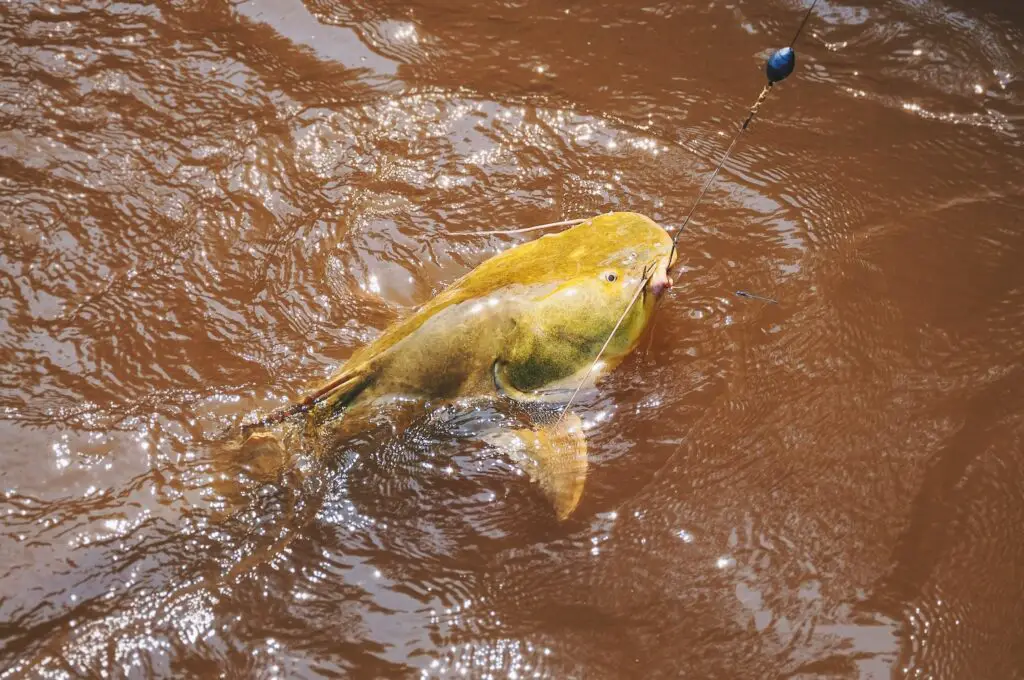The Dorado, also known as the Gilded Catfish, is a South American/Bolivian Amazon native species that originated in Wild Colombia and is known as the freshwater champion. A cute fact about this almost extinct species is that they can migrate over distances of nearly 800 kilometers throughout their lives, making them an energetic breed. The most common names for gilded catfish are Jau (Zungaro Zungaro), its scientific name, and Manguruyu (Black Manguruyu).
The appearance of Gilded Catfish/Jau
The shape of Gilded Catfish is fascinating to look at. This giant catfish can reach over 5 feet in size, which can be intimidating for most people out there. Mainly, its body is embodied in horizontally wide spots or rounded patches with leather-like skin and a huge back flapper. The color of this catfish is usually xanthous gray with a light-toned belly. The scales of this dorado catfish have a hue of silvery gold, thus getting the name Gilded Catfish. Like many other catfish, the gilded catfish has long barbels that help it find food in murky water and warn it of dangers it might not be able to see.

The size of the Gilded Catfish
Compared with other whiskered catfishes, gilded catfish are huge. A fact about dorado catfish is that they are a rare genus in the Bolivian Amazon. They have the body of two large sea fish, the tiger shovelnose and redtail catfish. It can weigh up to 178 pounds and grow to be 6’5′ long. This giant jellyfish has a long lifespan with this fish living up to eighteen years, with an average of ten years. It is said that the Dorado is one of the twelve large species of catfish in the River Sea.
For its massive build, it’s considered not a good fit for a private fish tank. One must have a gigantic custom-made tank for this fish if they want to pet it so that the fish can cultivate into a healthy adult in the house aquarium.
The Habitat of Gilded Catfish
The Gilded Catfish, starts its journey even before it can swim, and its life journey can span the entire Amazon. As it’s a fish native to South America and the Amazon Basin rivers, it’s mostly encountered in upstream riverbeds with swift currents and quaggy bottoms. It can also be seen in the Marron River, Canada, and Maku Maku Lake, Peru.
Gilded catfish begin their journey at the basin’s headwaters, where the mountains meet the jungle when they are still invertebrates. The current from the Andes rivers allows the baby gilded fish to cross the vast Amazon floodplains and reach the juvenile stage. When freshwater levels rise in rivers, young, gilded catfish often gather in groups and swim into salty waterways to feed on insects and fish. After the water level gets stable and returns to normal, the gilded catfish come back to the river.
As they are piscivorous, which means carnivorous animals feeding essentially on fish, they can be adapted to dead options like squid, crawfish, oysters, and fish filets. They also don’t mind gnawing on rotten meat. Anglers place baits like aracu, shiners, or dead lambari fish to capture Jau. A fun fact about these fish is that they like to move or hunt for food at night.
The Reproduction of Gilded Catfish
Given how gilded catfish live, it is probably impossible to breed them in a tank. It hatches upstream in the Amazon basin, near the Madeira River in Peru and Bolivia, and takes almost all the green tropical boats. Then, the baby fish are taken downstream to the delta river, where floodplains are low, taking up to 14–21 days. Around three years into their life cycle, they start migrating long distances to the exact place of hatching to spawn as they reach adulthood at ten kilograms. An adult Gilded Catfish travels for nearly one to two years to where it will reproduce, which is near South America’s west mountain range.
As it takes almost all the Amazonian riverbanks, including the Madeira basin, for its breeding, the genus suffer a handful of threats. The flow of the Madeira River, whose basin has been labeled the Amazonian basin, is broken in two places by hydroelectric dams built by human influence. Thus, acting as a blockade for migratory species and causing the quarantine of populations. As a result, adult fish can’t get to spawning grounds, and the marine ecosystem is being degraded.
Throughout this upriver movement, gilded catfish are subject to rigorous arrest by profit-oriented and small-scale fishing operations, thus going extinct.
The purpose of Gilded Catfish
All living beings have a purpose here on Earth; the same goes for the gilded catfish. It is an outstanding indicator species to keep track of kinship between basins and assess and observe the effects of framework and extractive industries. Besides, its importance for food security is unquestionable, especially for the fisheries of Southeastern Brazil. The abattoirs there export the meaty cutlets of this fish in large quantities to make money, as it is one of the most important sources of animal protein for thousands of people. According to the fishermen, the best time to catch gilded catfish is from June to September. It is also their responsibility to capture this genus in the Amazon.
Keeping aside all that, Gilded Catfish plays a key role in keeping the balance of the Amazonian basin by keeping the order of the green tropical. Like other migratory Goliath catfish, gilded catfish are a strong indicator of the health of the ecosystem.
Conclusion
As the jau fish, or gilded catfish, is the fourth most captured fish in the Amazon River, it is undoubtedly an important food fish. It is our responsibility to ensure that they do not become extinct due to humans’ involvement in fishing.











